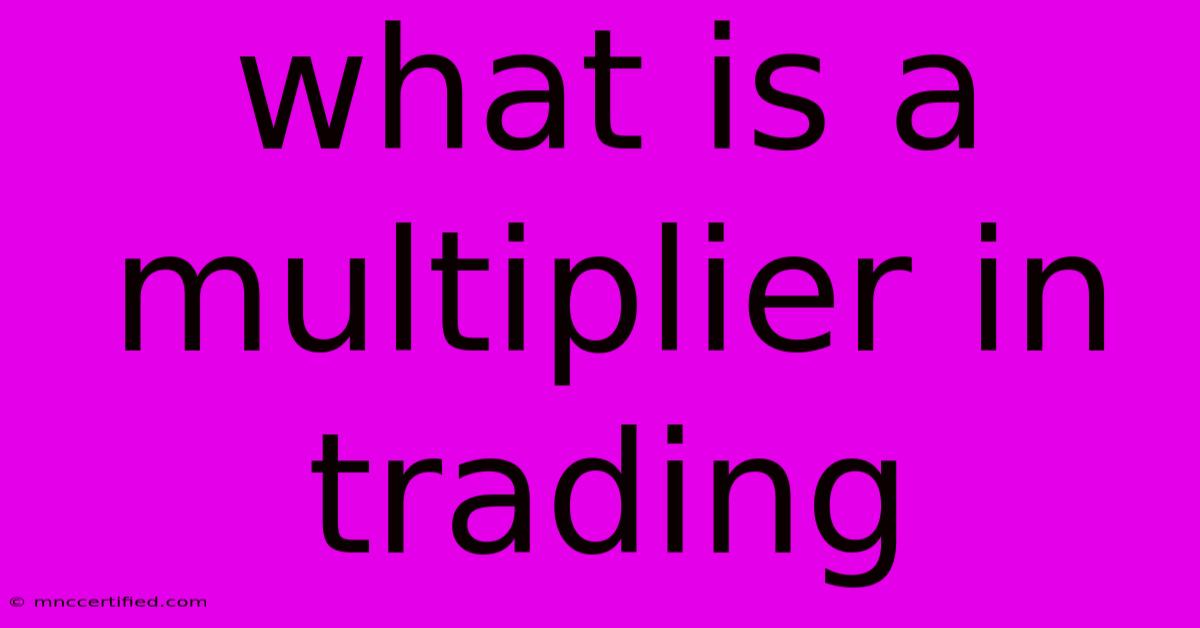What Is A Multiplier In Trading

Table of Contents
What is a Multiplier in Trading? A Comprehensive Guide
Understanding multipliers is crucial for anyone venturing into the world of trading, especially in leveraged markets like forex, futures, and CFDs. This comprehensive guide will demystify multipliers, explaining what they are, how they work, and their impact on your trading strategy. We'll also cover the crucial distinction between multipliers and leverage, a common point of confusion for beginners.
What is a Trading Multiplier?
A multiplier, in the context of trading, is a numerical factor that magnifies the notional value of a trade. It essentially increases the size of your position without requiring you to deposit the full amount. This allows traders to control larger positions with a relatively smaller investment. Think of it as a scaling factor that amplifies your profits (and losses) proportionally.
Let's illustrate with an example:
Imagine you're trading a currency pair with a multiplier of 100,000. If the price moves by one pip (the smallest price movement), your profit or loss will be calculated based on a 100,000 unit position, rather than one unit. This means even small price fluctuations can result in significant gains or losses.
How Multipliers Work in Different Trading Instruments
The application of multipliers varies slightly depending on the trading instrument:
Forex Trading:
In forex, multipliers are often expressed as units, such as 10,000, 100,000, or 1,000,000. This represents the number of units of the base currency you're trading. For example, a 100,000 multiplier on EUR/USD means you're trading 100,000 euros.
Futures Trading:
Futures contracts have specific contract sizes defined by the exchange. The multiplier is inherent in the contract itself and is applied to the price movement to determine your profit or loss. For example, a futures contract on a stock index might have a multiplier of 50, meaning each point movement in the index price changes the contract value by $50.
Contracts for Difference (CFDs):
Similar to forex, CFDs use multipliers to leverage your trading capital. The multiplier is usually specified by the broker and can vary depending on the underlying asset.
Multiplier vs. Leverage: Understanding the Key Difference
While often used interchangeably, multipliers and leverage are distinct concepts:
-
Multiplier: A numerical factor that scales the size of your position. It's a characteristic of the trading instrument or contract.
-
Leverage: The amount of borrowed capital used to amplify trading power. It's a ratio that expresses the relationship between your margin (own capital) and the total position size. For example, 1:100 leverage means you need to deposit 1% of the total trade value as margin.
The multiplier contributes to the effect of leverage, but it is not leverage itself. A higher multiplier increases the impact of leverage, leading to potentially larger profits or losses for a given price movement.
Risk Management and Multipliers: A Crucial Consideration
The use of multipliers magnifies both profits and losses. Therefore, risk management is paramount. Before employing multipliers in your trading, carefully consider:
- Account Size: Ensure your account balance can comfortably absorb potential losses, even with a high multiplier.
- Stop-Loss Orders: Always use stop-loss orders to limit potential losses to a predetermined level.
- Position Sizing: Determine the appropriate position size based on your risk tolerance and account size.
Conclusion: Mastering Multipliers for Successful Trading
Understanding multipliers is fundamental to successful trading in leveraged markets. By grasping how multipliers work and their impact on your trades, coupled with diligent risk management, you can harness their power to enhance your trading strategies while mitigating potential risks. Remember to thoroughly research the specific multipliers applied to your chosen instruments and always prioritize responsible trading practices.

Thank you for visiting our website wich cover about What Is A Multiplier In Trading. We hope the information provided has been useful to you. Feel free to contact us if you have any questions or need further assistance. See you next time and dont miss to bookmark.
Featured Posts
-
Untested Signing Trains With West Ham First Team
Nov 26, 2024
-
Band Aid 40 Geldof Responds To Criticism
Nov 26, 2024
-
Chief Investment Officer Search
Nov 26, 2024
-
Jon Benet Ramsey Why No Closure
Nov 26, 2024
-
Shelter Insurance Pocahontas Ar
Nov 26, 2024